warning DODGE GRAND CARAVAN 2004 Manual Online
[x] Cancel search | Manufacturer: DODGE, Model Year: 2004, Model line: GRAND CARAVAN, Model: DODGE GRAND CARAVAN 2004Pages: 397, PDF Size: 7.59 MB
Page 260 of 397
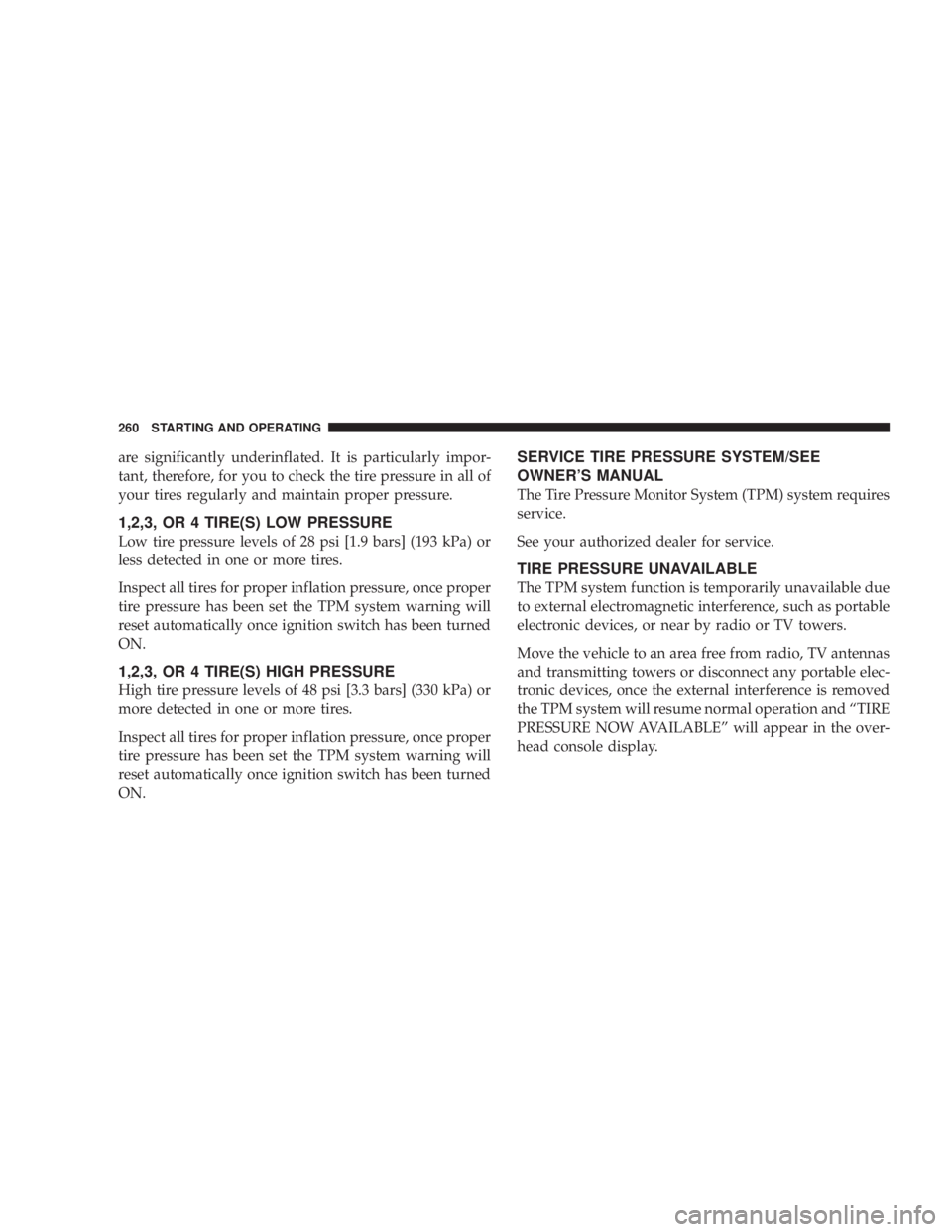
are significantly underinflated. It is particularly impor-
tant, therefore, for you to check the tire pressure in all of
your tires regularly and maintain proper pressure.
1,2,3, OR 4 TIRE(S) LOW PRESSURE
Low tire pressure levels of 28 psi [1.9 bars] (193 kPa) or
less detected in one or more tires.
Inspect all tires for proper inflation pressure, once proper
tire pressure has been set the TPM system warning will
reset automatically once ignition switch has been turned
ON.
1,2,3, OR 4 TIRE(S) HIGH PRESSURE
High tire pressure levels of 48 psi [3.3 bars] (330 kPa) or
more detected in one or more tires.
Inspect all tires for proper inflation pressure, once proper
tire pressure has been set the TPM system warning will
reset automatically once ignition switch has been turned
ON. SERVICE TIRE PRESSURE SYSTEM/SEE
OWNER'S MANUAL
The Tire Pressure Monitor System (TPM) system requires
service.
See your authorized dealer for service.
TIRE PRESSURE UNAVAILABLE
The TPM system function is temporarily unavailable due
to external electromagnetic interference, such as portable
electronic devices, or near by radio or TV towers.
Move the vehicle to an area free from radio, TV antennas
and transmitting towers or disconnect any portable elec-
tronic devices, once the external interference is removed
the TPM system will resume normal operation and ªTIRE
PRESSURE NOW AVAILABLEº will appear in the over-
head console display.260 STARTING AND OPERATING
Page 262 of 397

CAUTION!The TPM system has been optimized for the original
equipment tires and wheels. TPM system pressures
have been established for the tire size equipped on
your vehicle. Undesirable operation or sensor dam-
age may result when using replacement equipment
that is not of the same size, type, and/or style.
After-market wheels can cause sensor damage. Do
not use tire sealant or balance beads if your vehicle
is equipped with TPM system as damage to the
sensors may result.
NOTE:
² The TPM system can inform the driver of a low tire
pressure condition of 28 psi [1.9 bars] (193 kPa) or less,
or high a tire pressure condition of 48 psi [3.3 bars]
(330 kPa) or more. ² The TPM system is not intended to replace normal tire
care and maintenance, nor to provide warning of a tire
failure or condition.
² The TPM system should not be used as a tire pressure
gauge while adjusting your tire pressure.
² The TPM system must be retrained after a tire rotation
or wheel rim mounted sensor replacement. See your
authorized dealer for service.
CAUTION!After inspecting or adjusting the tire pressure al-
ways reinstall the valve stem cap. This will prevent
moisture and dirt entry into the valve stem, which
could damage the wheel rim sensor.262 STARTING AND OPERATING
Page 269 of 397
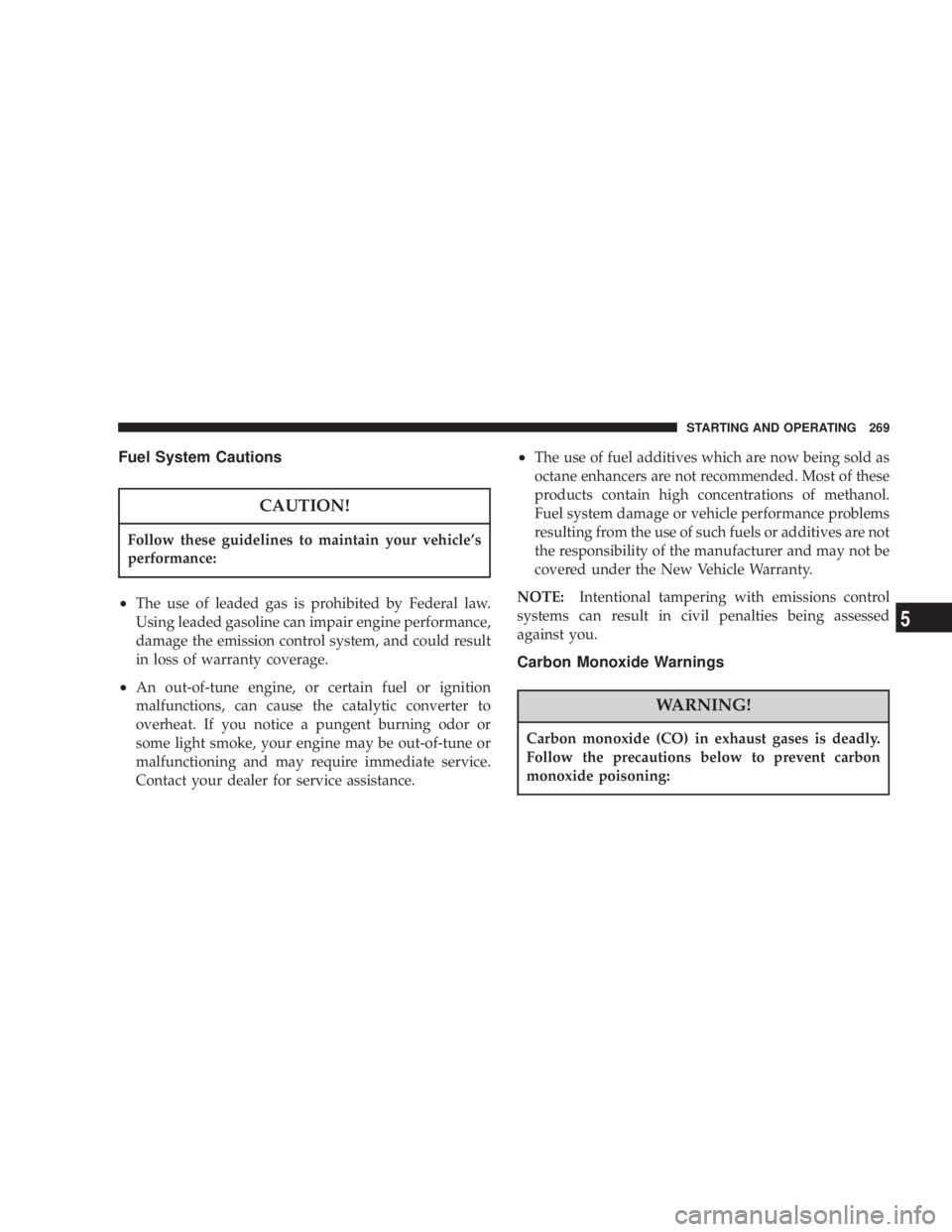
Fuel System Cautions
CAUTION!Follow these guidelines to maintain your vehicle's
performance:
² The use of leaded gas is prohibited by Federal law.
Using leaded gasoline can impair engine performance,
damage the emission control system, and could result
in loss of warranty coverage.
² An out-of-tune engine, or certain fuel or ignition
malfunctions, can cause the catalytic converter to
overheat. If you notice a pungent burning odor or
some light smoke, your engine may be out-of-tune or
malfunctioning and may require immediate service.
Contact your dealer for service assistance. ² The use of fuel additives which are now being sold as
octane enhancers are not recommended. Most of these
products contain high concentrations of methanol.
Fuel system damage or vehicle performance problems
resulting from the use of such fuels or additives are not
the responsibility of the manufacturer and may not be
covered under the New Vehicle Warranty.
NOTE: Intentional tampering with emissions control
systems can result in civil penalties being assessed
against you.
Carbon Monoxide Warnings
WARNING!Carbon monoxide (CO) in exhaust gases is deadly.
Follow the precautions below to prevent carbon
monoxide poisoning: STARTING AND OPERATING 269
5
Page 272 of 397
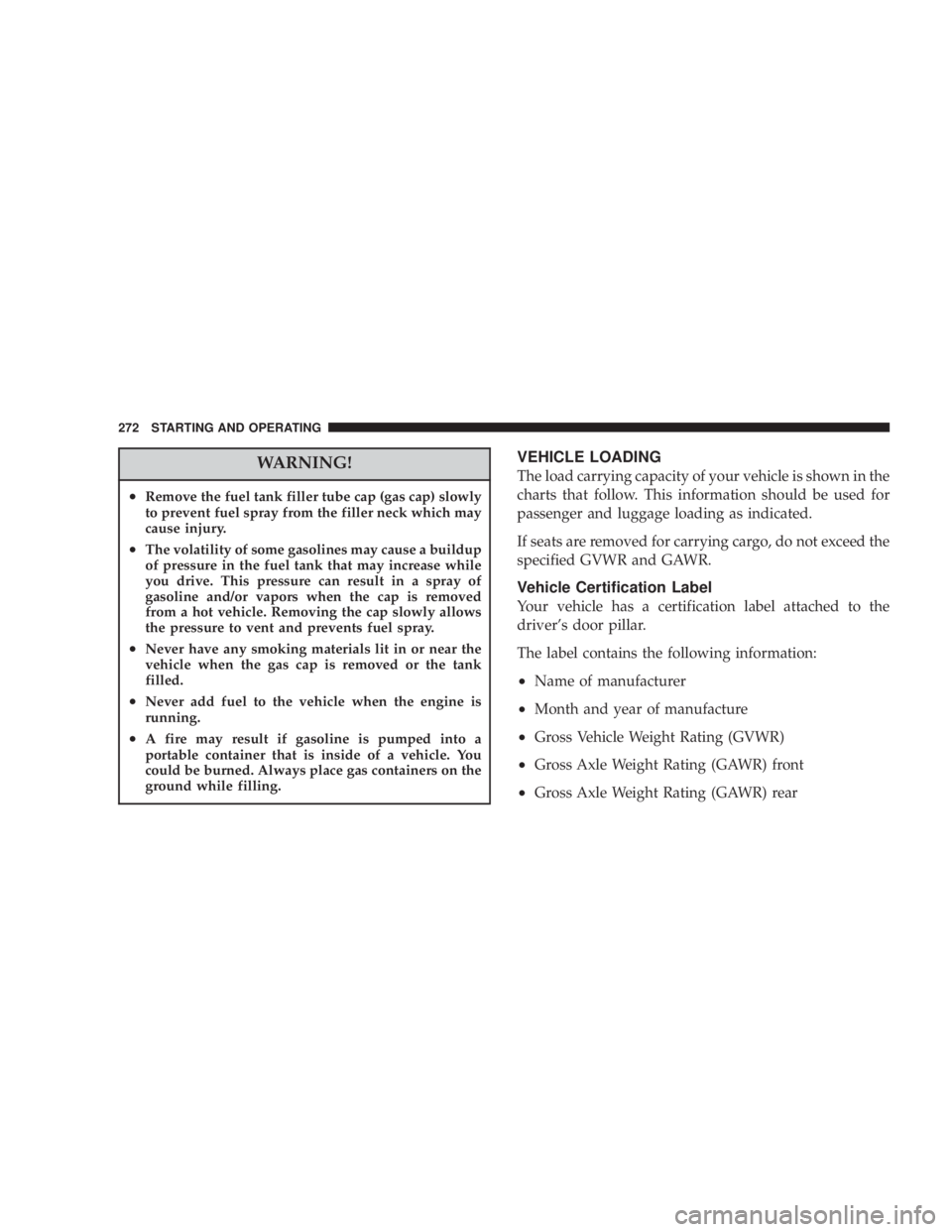
WARNING!² Remove the fuel tank filler tube cap (gas cap) slowly
to prevent fuel spray from the filler neck which may
cause injury.
² The volatility of some gasolines may cause a buildup
of pressure in the fuel tank that may increase while
you drive. This pressure can result in a spray of
gasoline and/or vapors when the cap is removed
from a hot vehicle. Removing the cap slowly allows
the pressure to vent and prevents fuel spray.
² Never have any smoking materials lit in or near the
vehicle when the gas cap is removed or the tank
filled.
² Never add fuel to the vehicle when the engine is
running.
² A fire may result if gasoline is pumped into a
portable container that is inside of a vehicle. You
could be burned. Always place gas containers on the
ground while filling. VEHICLE LOADING
The load carrying capacity of your vehicle is shown in the
charts that follow. This information should be used for
passenger and luggage loading as indicated.
If seats are removed for carrying cargo, do not exceed the
specified GVWR and GAWR.
Vehicle Certification Label
Your vehicle has a certification label attached to the
driver's door pillar.
The label contains the following information:
² Name of manufacturer
² Month and year of manufacture
² Gross Vehicle Weight Rating (GVWR)
² Gross Axle Weight Rating (GAWR) front
² Gross Axle Weight Rating (GAWR) rear272 STARTING AND OPERATING
Page 273 of 397
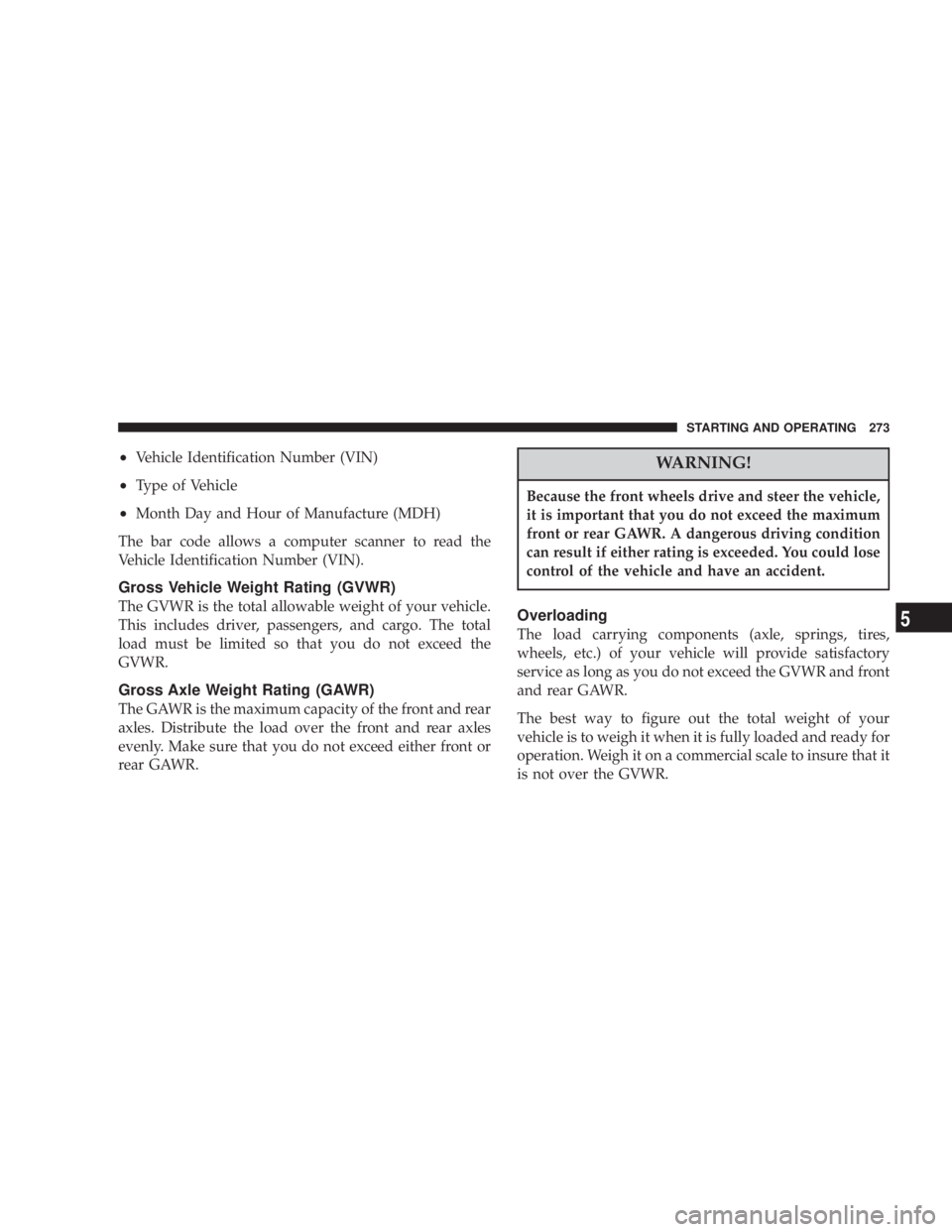
² Vehicle Identification Number (VIN)
² Type of Vehicle
² Month Day and Hour of Manufacture (MDH)
The bar code allows a computer scanner to read the
Vehicle Identification Number (VIN).
Gross Vehicle Weight Rating (GVWR)
The GVWR is the total allowable weight of your vehicle.
This includes driver, passengers, and cargo. The total
load must be limited so that you do not exceed the
GVWR.
Gross Axle Weight Rating (GAWR)
The GAWR is the maximum capacity of the front and rear
axles. Distribute the load over the front and rear axles
evenly. Make sure that you do not exceed either front or
rear GAWR. WARNING!Because the front wheels drive and steer the vehicle,
it is important that you do not exceed the maximum
front or rear GAWR. A dangerous driving condition
can result if either rating is exceeded. You could lose
control of the vehicle and have an accident.
Overloading
The load carrying components (axle, springs, tires,
wheels, etc.) of your vehicle will provide satisfactory
service as long as you do not exceed the GVWR and front
and rear GAWR.
The best way to figure out the total weight of your
vehicle is to weigh it when it is fully loaded and ready for
operation. Weigh it on a commercial scale to insure that it
is not over the GVWR. STARTING AND OPERATING 273
5
Page 276 of 397
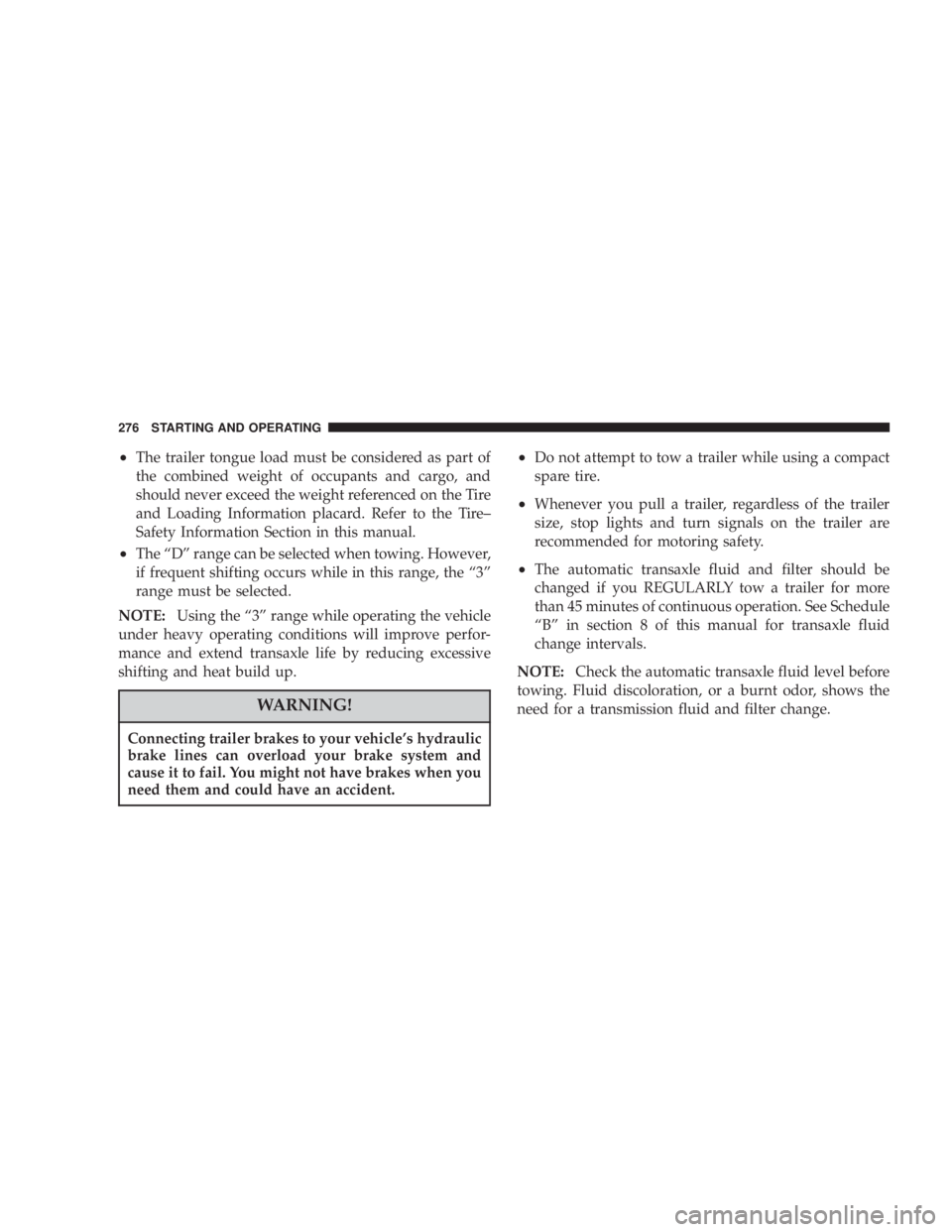
² The trailer tongue load must be considered as part of
the combined weight of occupants and cargo, and
should never exceed the weight referenced on the Tire
and Loading Information placard. Refer to the Tire±
Safety Information Section in this manual.
² The ªDº range can be selected when towing. However,
if frequent shifting occurs while in this range, the ª3º
range must be selected.
NOTE: Using the ª3º range while operating the vehicle
under heavy operating conditions will improve perfor-
mance and extend transaxle life by reducing excessive
shifting and heat build up.
WARNING!Connecting trailer brakes to your vehicle's hydraulic
brake lines can overload your brake system and
cause it to fail. You might not have brakes when you
need them and could have an accident. ² Do not attempt to tow a trailer while using a compact
spare tire.
² Whenever you pull a trailer, regardless of the trailer
size, stop lights and turn signals on the trailer are
recommended for motoring safety.
² The automatic transaxle fluid and filter should be
changed if you REGULARLY tow a trailer for more
than 45 minutes of continuous operation. See Schedule
ªBº in section 8 of this manual for transaxle fluid
change intervals.
NOTE: Check the automatic transaxle fluid level before
towing. Fluid discoloration, or a burnt odor, shows the
need for a transmission fluid and filter change.276 STARTING AND OPERATING
Page 278 of 397

A load equalizing hitch is recommended for loaded
trailer weights above 1,000 lbs (454 kg) and required for
weights above 2,000 lbs (907 kg).
CAUTION!If the trailer weighs more than 1,000 lbs (454 kg)
loaded, it should have its own brakes and they
should be of adequate capacity. Failure to do this
could lead to accelerated brake lining wear, higher
brake pedal effort, and longer stopping distances. WARNING!Connecting trailer brakes to your vehicle's hydraulic
brake lines can overload your brake system and
cause it to fail. You might not have brakes when you
need them and could have an accident.278 STARTING AND OPERATING
Page 279 of 397
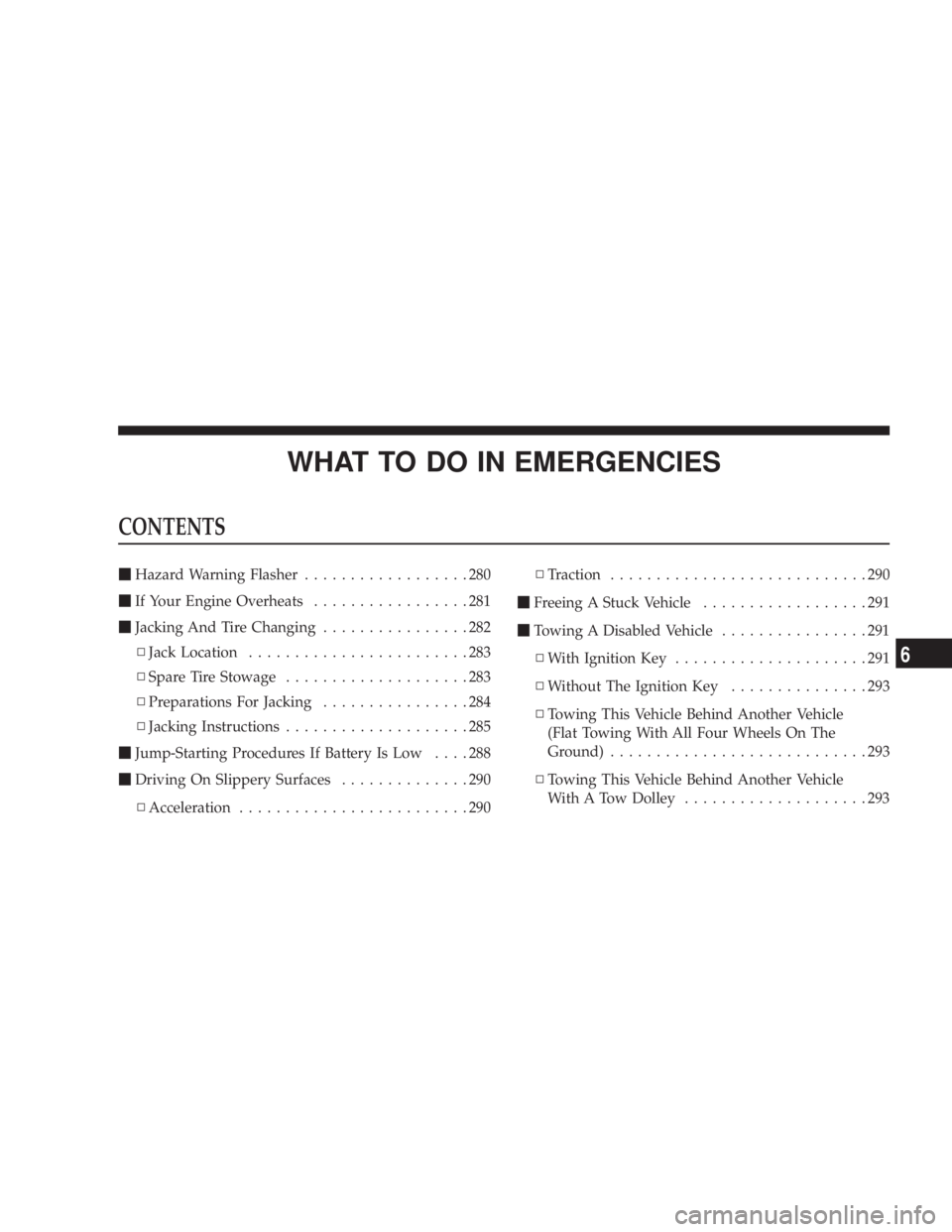
WHAT TO DO IN EMERGENCIESCONTENTS m Hazard Warning Flasher ..................280
m If Your Engine Overheats .................281
m Jacking And Tire Changing ................282
N Jack Location ........................283
N Spare Tire Stowage ....................283
N Preparations For Jacking ................284
N Jacking Instructions ....................285
m Jump-Starting Procedures If Battery Is Low ....288
m Driving On Slippery Surfaces ..............290
N Acceleration .........................290 N Traction ............................290
m Freeing A Stuck Vehicle ..................291
m Towing A Disabled Vehicle ................291
N With Ignition Key .....................291
N Without The Ignition Key ...............293
N Towing This Vehicle Behind Another Vehicle
(Flat Towing With All Four Wheels On The
Ground) ............................293
N Towing This Vehicle Behind Another Vehicle
With A Tow Dolley ....................293
6
Page 280 of 397
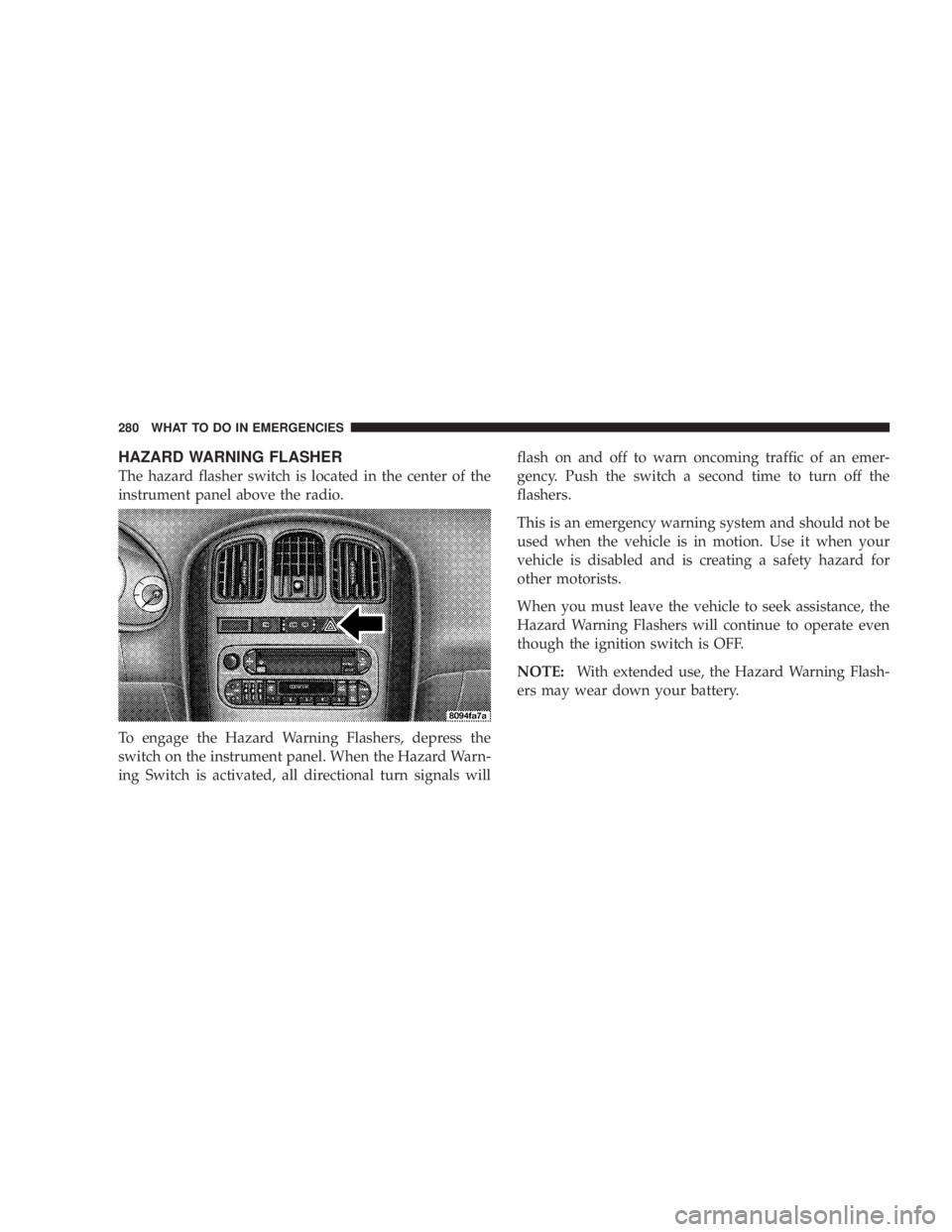
HAZARD WARNING FLASHER
The hazard flasher switch is located in the center of the
instrument panel above the radio.
To engage the Hazard Warning Flashers, depress the
switch on the instrument panel. When the Hazard Warn-
ing Switch is activated, all directional turn signals will flash on and off to warn oncoming traffic of an emer-
gency. Push the switch a second time to turn off the
flashers.
This is an emergency warning system and should not be
used when the vehicle is in motion. Use it when your
vehicle is disabled and is creating a safety hazard for
other motorists.
When you must leave the vehicle to seek assistance, the
Hazard Warning Flashers will continue to operate even
though the ignition switch is OFF.
NOTE: With extended use, the Hazard Warning Flash-
ers may wear down your battery.280 WHAT TO DO IN EMERGENCIES
Page 282 of 397

WARNING!A hot engine cooling system is dangerous. You or
others could be badly burned by steam or boiling
coolant. You may want to call a service center if your
vehicle overheats. If you decide to look under the
hood yourself, see Section 7, Maintenance, of this
manual. Follow the warnings under the Cooling
System Pressure Cap paragraph. JACKING AND TIRE CHANGING
WARNING!² Getting under a jacked-up vehicle is dangerous.
The vehicle could slip off the jack and fall on you.
You could be crushed. Never get any part of your
body under a vehicle that is on a jack. If you need
to get under a raised vehicle, take it to a service
center where it can be raised on a lift.
² The jack is designed to use as a tool for changing
tires only. The jack should not be used to lift the
vehicle for service purposes. The vehicle should
be jacked on a firm level surface only. Avoid ice or
slippery areas.282 WHAT TO DO IN EMERGENCIES